Sheryl Shook
Blood Lab
Learning Objectives
- Explain hematocrit, including the significance of values outside of the normal range.
- Determine hematocrit from a blood sample image.
- Explain the ABO and Rh blood groups and their clinical significance.
- Conduct blood typing on a synthetic-blood sample.
- Identify and describe all formed elements in a human blood smear.
- State the relative proportions of formed elements in human blood.
- Demonstrate proficient microscope use.
Blood Composition and Hematocrit
Composition of blood
Overview of Blood [link opens in new window]
- 55% = Plasma
- Proteins (for blood pressure, clotting, and immune functions)
- Water (92% of plasma)
- Electrolytes
- Hormones
- Nutrients
- Blood gases
- Waste
- 45% = Formed Elements
- Red Blood Cells (erythrocytes)
- Platelets (thrombocytes)
- White Blood Cells (leukocytes)
Hematocrit
- Definition: The volume—reported as a percentage—of packed elements (mainly red blood cells) in a blood sample.
- Clinical relevance: Provides information about the oxygen-carrying capacity of blood. Low hematocrit means less red blood cells carrying O2.
- Healthy ranges:
- Male: ____________%
- Female:____________%
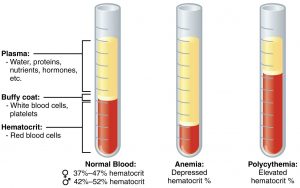
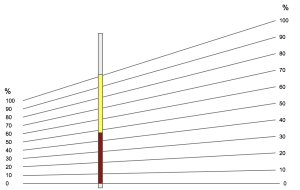
Blood Typing
Blood type refers to the presence or absence of specific molecules, called antigens, on the red blood cell (RBC) RBC surface. Antigens are molecules, such as proteins, lipids, carbohydrates or nucleic acids, that your body can use to differentiate self and non-self. People with different blood types have different antigens on their RBCs.
Antibodies are produced in response to some antigens (non-self), and are generally used by the immune system to recognize and facilitate removal of objects (viruses, bacteria, tumorous cells, etc.) that do not belong in the body.
There are more than 50 blood types in the human population. The most clinically significant are the ABO and Rh(+/-) blood groups.
The ABO Blood Group
A and B antigens are glycoproteins on the RCC surface. ABO typing does not affect a person’s Rh (+ or -) designation. Figure 2.3 Blood Type
Type A blood: A antigens on cell; anti-B antibodies in plasma
Type B blood: B antigens on cell; anti-A antibodies in plasma
Type AB blood: both A and B antigens on cell; neither anti-A nor anti-B antibodies in plasma
Type O blood: neither A nor B antigens on cell; both anti-A and anti-B antibodies in plasma
If a different type of blood is put into your bloodstream, the blood will agglutinate (clump) and hemolysis (bursting) occurs within the foreign blood cells. Agglutination due to antibodies and antigens is a different process than blood clotting, which involves fibrin and other cascades associated with hemostasis.
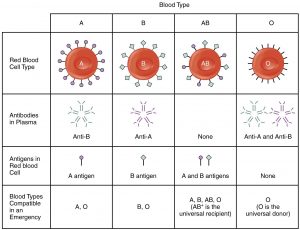
Rh Blood Group
Rh antigens are named after the rhesus macaque, a primate with many blood similarities to human. There are many Rh antigens in humans, but the D type of Rh antigen is the most clinically significant. Because of this, in blood typing, sometimes D and Rh are used interchangeably. The Rh factor is grouped with ABO blood group to identify a blood type (example A+, B-, O-).
Type Rh+ (positive) blood: Rh antigens on cell
Type Rh- (negative) blood: no Rh antigens on cell
Unlike ABO blood type, no anti-Rh antibodies are present in Rh- individuals unless they have been exposed to Rh antigens. If Rh+ blood is introduced into an Rh- individual, anti-Rh antibodies will be produced against the Rh(+) blood.
Importance of Rh during Pregnancy
This is a critical consideration in pregnancy for Rh- mothers if the fetus is Rh+. If any of the Rh+ blood enters the mother’s circulation, the mother’s immune system will produce anti-Rh antibodies that will hemolyze her baby’s blood (and any future Rh+ fetuses). This is called hemolytic disease of the newborn or erythroblastosis fetalis. It is prevented with RhoGAM, a dosage of anti-Rh antibodies, given to the mother at 27 weeks and within 72 hours of giving birth in order to destroy any fetal blood cells in her blood so she will not produce her own anti-Rh antibodies. RhoGam antibody dosage is small enough not to hurt fetus, but strong enough to keep mom’s immune system from attacking fetus. See Figure 2.4.
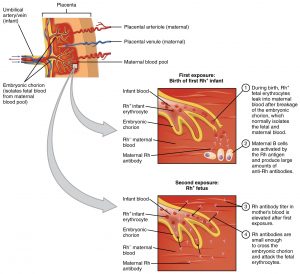
Determining Blood Type
To determine blood types, antiserum is used. The serum contains antibodies that may react with antigens on the RBC surface.
If using anti-A antiserum (contains anti-A antibodies) and the blood sample agglutinates (clumps), this indicates the presence of A antigens.
Which blood types have A antigens? Fill in the type. Type _____ and Type _____
If using anti-B antiserum (contains anti-B antibodies) and the blood sample agglutinates (clumps), this indicates the presence of B antigens.
Which blood types have B antigens? Fill in the type. Type _____ and Type _____
If using anti-Rh (anti-D) antiserum (contains anti-Rh (anti-D) antibodies) and the blood sample agglutinates (clumps), this indicates the presence of Rh antigens.
Which blood type has Rh antigens? Fill in the type. Type _____
Blood Typing Data
Complete the blood typing on your samples and enter your data in Table 2.1.
For each blood sample:
- Place a drop of blood in each of the three depressions of one testing tray. Each depression has a label of A, B, or Rh(D). One tray is used for each blood sample.
- Place a drop of the antiserum that is associated with each depression. For example anti-A antiserum (containing anti-A antibodies) goes into the depression marked A. In that depression, you will be testing to see if the anti-A antibodies agglutinate RBCs with A antigens. Do the same for anti-B and anti-Rh sera into each of their depressions in the tray.
- Stir the combination of the blood and antiserum in each depression with the color coded toothpick. Do not mix toothpicks across depressions.
- Examine the samples for agglutination and fill out your data table to determine the blood type for each sample.
| Using blood sample | Antiserum contains antibody Anti-A and tests for antigen A | Antiserum contains antibody Anti-B and tests for antigen B | Antiserum contains antibody Anti-Rh (D) and tests for antigen Rh (D) | What is the blood type? |
| Blood sample 1 | Agglutinated? Yes or No |
Agglutinated? Yes or No |
Agglutinated? Yes or No |
Type: |
| Blood sample 2 | Agglutinated? Yes or No |
Agglutinated? Yes or No |
Agglutinated? Yes or No |
Type: |
| Blood sample 3 | Agglutinated? Yes or No |
Agglutinated? Yes or No |
Agglutinated? Yes or No |
Type: |
| Blood sample 4 | Agglutinated? Yes or No |
Agglutinated? Yes or No |
Agglutinated? Yes or No |
Type: |
Table 2.1 Blood Typing Data
Human Blood Microscopy and General Microscope Use
In this part of the lab you will use a microscope to examine erythrocytes, leukocytes, and platelets. These three constituents are referred to as the formed elements of blood. Platelets are not considered a cell, as they are enclosed cytoplasmic fragments. A complete blood count with differential is a clinical measure that states the percentages of each blood cell type and is used for various diagnostics such as determining anemia or types of infections or allergic reactions. Erythrocytes are the most numerous blood cell, and then the count of the different leukocytes goes from most to least numerous in this order: neutrophils, lymphocytes, monocytes, eosinophils, and basophils.
Formed Elements of Blood
Erythrocytes (Red Blood Cells)
See Figure 2.5 below and notice the numerous, round, pink cells in the background each of the leukocyte images. These are red blood cells (RBCs). Some look like they have a hole in the middle, but this is due to the thin area of the biconcave shape that allows for flexibility and to increase surface area.
Primary function: transport respiratory gases to and from tissues.
Lack a nucleus.
Most abundant of all blood cells.
Contains millions of Hemoglobin molecules: allow for binding of O2 and CO2.
Platelets
Also called thrombocytes but not technically a cell. They are produced by the fragmentation megakaryocytes that are in bone marrow tissue.
Involved in coagulation: the process of clot formation.
During coagulation, molecules (fibrin) join to form long threads that form a net to trap platelets and plug the wound.
Leukocytes (White Blood Cells)
See Figure 2.5 below.
Only formed elements with a nucleus.
Lacks hemoglobin.
Travel between endothelial cells of capillaries and tissues.
Two types of leukocytes: granular and agranular.

Granulocytes
See Figure 2.6 below.
All have granules in cytoplasm.
- Neutrophils (40-60% of total white blood cell (WBC) count)
- most common WBC
- 1st to arrive at wound/infection site
- release cytotoxins
- capable of phagocytosis
- Eosinophils (1-4% of total WBC count)
- phagocytize microbes that immune system has coated with antibodies
- decrease inflammatory response at site of wound
- Basophil (0.5-1% of WBC count)
- release histamines (cause vasodilation) and heparin (prevents clotting)
- important in allergies

Agranulocytes
Refer back to Figure 2.5
Fewer and less obvious granules in cytoplasm.
- Monocytes (2-8% of total WBC count)
- wanderers, patrol body tissue for microbes and worn-out tissue cells
- 2nd to arrive at wound site
- phagocytize dead cells/debris that has accumulated at site of wound/infection
- Lymphocytes (20-40% of WBCs)
- smallest leukocyte, abundant in bloodstream, occur in lymph nodes and glands
- specialized lymphocytes:
- T-cells: attach to and destroy infected or cancerous cells by releasing cytotoxic molecules and secreting antiviral/proinflammatory molecules
- B-cells: manufacture antibodies that attach to foreign pathogens/cells and help destroy them
- Natural Killer cells: can detect sick, cancerous, and infected cells and release cytotoxic molecules to destroy them
Follow the instructions below for microscope use, and examine a human blood smear. Sketch each of the formed elements of blood as seen in your view.
Microscope Parts and How To Handle Them
There are many different types of microscopes. We shall learn about the compound light microscope. It uses visible light to visualize the specimen, and passes that light through two separate lenses to magnify the image. Compound microscopes have a lot of moving parts and can be damaged and broken through mishandling. A large part of learning how to use the microscope properly involves learning how to avoid damaging it. To do that, you first have to be familiar with the parts.
In Figure 2.7, there are two compound microscopes shown with key parts identified. The one on the left is monocular and the one on the right is binocular. Many of the parts of the two microscopes are in slightly different locations.
When you first sit in front of a microscope, take a moment to find the key parts, especially the knobs for focus, condenser adjustment, and stage control. When viewing a specimen, your eyes will be at the eyepieces (oculars), and if you grab the wrong knob by accident, you can lose your image or damage the microscope.
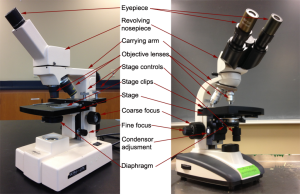
Eyepiece (Ocular)
The eyepiece contains the eyepiece lens, one of the two lenses doing the magnifying in a compound microscope. If the microscope is binocular, use both eyepieces, adjusting them to ensure they fit the spacing of your eyes. For successful binocular viewing, bring your image into focus with the lowest power objective, while looking through only the non-adjustable ocular. Then while looking only through the adjustable ocular, rotate its focus ring to bring that ocular into clear focus. Now the image should be clear as you look through both oculars.
Carrying arm
When moving a microscope, even if it is just a few inches, always pick it up by the carrying arm. Do not drag the microscope: pick it up. The microscope will have rubber feet that prevent it from sliding, so if you try to drag it, it will shake and vibrate and possibly damage parts. Never pick up the microscope by any part other than the carrying arm. The other parts are generally much more fragile and prone to breaking.
Objective lenses
Most compound light microscopes will contain three to four objective lenses that can be rotated over the slide. Sometimes these lenses are just called objectives. When a particular objective has been fully rotated into position, you will feel a click as that objective locks into place. The objective lens is the second of the two lenses doing the magnifying in a compound microscope, so if it is not snapped into proper position, you will not see the proper image. Each objective lens can usually be unscrewed from its position in the rotating turret that houses it, so be careful you are rotating the turret, not unscrewing an objective. Do not unscrew the objectives from the turret. Each objective lens has a different magnifying power, so the image on your slide will be magnified to lesser or greater extents, depending on which objective lens you have chosen. Each objective’s magnification power will be written somewhere on the side of the objective.
Stage and stage clips
The slide will be held in place on the stage with stage clips that press against the sides of the slide. The clips do not sit above or below the slide. They are spring-loaded to hold the slide edges and lock the slide in place so that the stage controls can move the position of the slide smoothly.
Stage controls
These allow you to move your slide while you are viewing it, but only if the slide is properly clipped in with the stage clips. Find the stage control dials on your microscope before you start viewing your slide. There are two dials—one moves the slide left and right, the other moves the slide up and down. Notice in Figure 2.7, the dials are on top of each other and below the stage on the binocular microscope, however, they are two separate dials and above the stage on the monocular microscope.
Coarse focus
This is the larger of the two focus knobs. Use it with the lowest power objective to get the specimen approximately in focus. After that, only use the fine focus knob, even after you change to a higher-power objective. Notice in Figure 2.7, the binocular microscope fine focus knob is surrounded by the coarse focus knob, however, the monocular microscope coarse focus and fine focus knobs are separated.
Fine focus
This is the smaller of the two focus knobs. This is the focus you will use repeatedly in viewing slides once they are focused with the coarse focus.
Condenser position adjustment
You typically will not need to adjust this knob. It controls how far the light condenser is from the slide, which should be properly adjusted before you use the microscope.
Condenser opening adjustment (not shown in figure)
This opening can be adjusted, usually by rotating a ring around the condenser. Be sure this has not been left closed by a previous user. Experiment with different opening sizes to determine what is best for your specimen.
Iris diaphragm lever
Find the lever under the stage where light passes through to the slide. It opens and closes an iris to let more or less light through the slide. In some specimens there is not much contrast between the colours and shades of the different components being magnified. Changing the view by adjusting the iris can allow you to better see some of the details you are trying to magnify.
Rheostat: Light intensity (not shown in figure)
Rotate this dial to adjust the brightness of the light source. Turn this to its a low setting before looking through the eyepieces. You may need to increase the intensity as you increase the power of your objective. Turn the rheostat all the way down before turning off your microscope.
Lab exercises
Carry out the activities listed below and answer the questions.
- Pick up your microscope and bring it close enough that you can look into it comfortably from where you are sitting with healthy posture. Arrange it so that the stage is facing you and the eyepieces are rotated toward you. What part of the microscope did you grab in order to pick it up and move it?
- Where are the locations of the two stage adjustment knobs on your microscope?
- Where is the location of the coarse focus knob?
- Where is the location of the fine focus knob?
- Is there a condenser opening adjustment ring?
- Find the diaphragm lever. Looking in the hole in the center of the stage, what happens when you move the diaphragm lever in each direction?
- After cleaning a slide as instructed by your professor, place the slide on the stage.
- Take the steps described in the ocular section to obtain clear view through both of your oculars. If you wear glasses, try with and without to determine which is best for you.
- Adjust the condenser opening and iris lever. How does this change your view?
Checking out and storing the microscope
When you finish your microscope work with the blood slide, be prepared to have your instructor check off each of these items before putting away your microscope.
- Turn the rheostat to its dimmest setting.
- Turn off the power, unplug, and wrap the cord around the base.
- Wipe the objective lenses with methanol and lens paper. Notice this is lens paper, not kimwipes. Using any paper other than lens paper can scratch the lens.
- Rotate the objective lens turret so the lowest power objective faces down.
- Wipe the stage clean with a kimwipe and move it to the lowest position.
“Blood Lab” is MODIFIED from:
- Anatomy and Physiology by Open Stax / CC BY 4.0. Download for free at http://cnx.org/contents/14fb4ad7-39a1-4eee-ab6e-3ef2482e3e22@12.8.
- An Overview of Blood, Anatomy and Physiology by Open Stax / CC BY 4.0. https://cnx.org/contents/FPtK1zmh@12.8:IUrEdFyf@10/An-Overview-of-Blood
- UGA Anatomy and Physiology 2 Lab Manual by University System of Georgia / CC BY 4.0
- Human Anatomy and Physiology Lab (BSB 141) by Lumen Learning / CC BY-SA
- A&P Labs. Authored by: Ross Whitwam. Provided by: Mississippi University for Women. Located at: http://www.muw.edu/. License: CC BY-SA: Attribution-ShareAlike
- Labeled compound light microscope. Authored by: Ross Whitwam. Provided by: Mississippi University for Women. Located at: http://www.muw.edu/. License: CC BY-SA: Attribution-ShareAlike
Citation notes:
- Hesse, DeLoris; Cozart, Deanna; Szymik, Brett; and Nichols, Rob, “UGA Anatomy and Physiology 2 Lab Manual” (2017). Biological Sciences Open Textbooks. 14.
https://oer.galileo.usg.edu/biology-textbooks/14
“Microscope Parts and How to Handle Them” is MODIFIED from:
- Lumen Learning. CC BY-SA https://courses.lumenlearning.com/ap1x9x1/chapter/the-parts-of-a-compound-microscope-and-how-to-handle-them-correctly/
- A&P Labs. Authored by: Ross Whitwam. Provided by: Mississippi University for Women. Located at: http://www.muw.edu/. License: CC BY-SA: Attribution-ShareAlike
- Labelled compound light microscope. Authored by: Ross Whitwam. Provided by: Mississippi University for Women. Located at: http://www.muw.edu/. License: CC BY-SA: Attribution-ShareAlike
